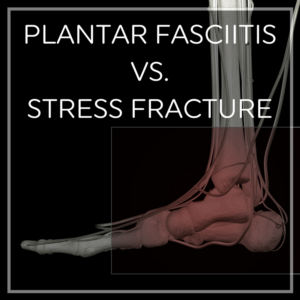 You had a hard workout yesterday and wake up to find that your heel pain is absolutely unbearable.
You had a hard workout yesterday and wake up to find that your heel pain is absolutely unbearable.
Making a quick assessment of your situation is important so that you can get the treatment you need, avoiding additional injury, and preventing long-term damage.
But both Plantar Fasciitis and stress fractures can involve intense heel pain that makes weight-bearing activities difficult.
So is it Plantar Fasciitis, or is it a stress fracture?
Each of these two conditions has unique hallmarks that will help you and your doctor make a quick and accurate diagnosis:

Do You Have Plantar Fasciitis?
The thick, flexible tissue connecting your heel to the ball of your foot (AKA the arch of your foot) bears the brunt of the impact and distributes the weight of your body as you walk, run, or jump. When the plantar fascia becomes damaged through overuse or injury, this band of tissue can sustain small tears or become inflamed. When that happens, you have a condition called Plantar Fasciitis.
Causes of Plantar Fasciitis
Plantar fasciitis is caused by overuse or injury to the arches. The subsequent inflammation and damage results in heel pain that can be excruciating, especially the first thing in the morning. Plantar fasciitis can be caused or exacerbated by any of the following:
- Intense exercise sessions, especially if the muscles are ligaments aren’t properly warmed up
- Weight gain that results in additional strain and impact to the arches
- Walking, standing, or running without supportive foot and arch support
- Flat or high arches that don’t allow for proper weight distribution in the feet
Symptoms and Telltale Signs of Plantar Fasciitis

The biggest telltale sign of Plantar Fasciitis (and one of the best ways to distinguish it from a stress fracture) is that the pain is worse with those first few steps in the morning, that improves slightly with use and movement as the fascia stretches and warms up.
Other classic symptoms of Plantar Fasciitis include the following:
- Achy, stiff heels and arches
- Redness, swelling, and inflammation in the heel and along the arch
- Pain that is worse in the morning or after inactivity
- Pain that improves with rest, stretching exercises, and icing
- Persistent dull pain, or sharp, needle-like pain that may cause you to limp
Diagnosing Plantar Fasciitis
Your doctor will diagnose Plantar Fasciitis based on your lifestyle, medical history, and an examination of your heel and arch. If a stress fracture is suspected or needs to be ruled out, your doctor will also probably take x-rays. While x-rays can’t always confirm Plantar Fasciitis, your doctor will look for thickening and inflammation of the plantar fascia, as well as the presence of heel spurs (rigid calcium deposits on the heel bone in response to trauma and inflammation). However, heel spurs are not found in all cases of plantar fasciitis.
Treatment for Plantar Fasciitis
More than 90% of plantar fasciitis cases can be successfully resolved with conservative treatment methods to reduce inflammation better support your arches:
- Regular stretching
- Icing the heel and plantar fascia
- Shoes that fit properly and support your heel and fascia
- Regular use of orthotics like Heel Seats
- Changes to your diet (to avoid inflammatory foods and maintain a healthy weight)
- Anti-inflammatory medication to manage pain, including ibuprofen
Unlike Plantar Fasciitis, the pain from a stress fracture usually gets worse with physical activity. While a stress fracture can result from the same causes and activities as plantar fasciitis, a fracture must be treated differently to avoid further damage and pain.
Do You Have a Stress Fracture?

Like Plantar Fasciitis, stress fractures are often caused by overly intense exercise, overuse, and high impact. However, while plantar fasciitis is an injury to a ligament in the arch of the foot, a stress fracture is a small crack or fissure in one of the bones in the heel or foot.
Causes of Stress Fractures
Stress fractures can be caused by overuse, injury, or the overall condition of your bones. If you have osteoporosis, are taking medication that makes your bones more fragile, or are deficient in Vitamin D, it’s possible to sustain a stress fracture even during normal daily activities. Stress fractures are often caused by the following factors:
- Increasing the intensity of a workout or sports activity without warming up gradually or building endurance
- Not allowing for proper rest between workouts
- Running, walking, or exercising on hard, uneven surfaces
- Wearing shoes that don’t fit properly, or don’t provide proper cushioning and support
- Osteoporosis or medications that weaken the bones
- Diets that are deficient in Vitamin D and calcium
- Trauma
Symptoms and Telltale Signs of Stress Fractures
While the pain from plantar fasciitis can have a rapid onset in some cases, the pain typically increases gradually. With a stress fracture, you’ll likely notice a more sudden onset of intense pain. Stress fractures can be the result of a fall or sudden impact, or they may be the result of vigorous exercise regimens that don’t allow the bones in the heel or foot to heal from micro-injuries over time. You should also look for these telltale symptoms:
- Pain that gets worse the longer you’re on your feet
- Intense pain that is localized to one spot on the heel or foot, and is tender to the touch
- Redness and swelling at the fracture site
- Pain that gets worse with stretching
Diagnosing a Stress Fracture

If you suspect you have a stress fracture in your heel or foot, it’s important to get medical attention right away to avoid further damage or a full break in the bone. Your doctor will examine your foot and will likely take x-rays to confirm the fracture. Since stress fractures are very tiny, it’s sometimes difficult to see them on an x-ray. If your symptoms indicate a stress fracture, your doctor may decide to treat you for this condition regardless of whether the fracture shows up on an x-ray.
Treatment for Stress Fractures
While you wait for your doctor’s appointment, do everything possible to avoid further damage or a complete break in the bone. Rest your foot, ice the area for 10-15 minutes in intervals throughout the day, wrap the foot with KT tape or an Ace Bandage for stability, and elevate the foot to reduce swelling. Try to avoid putting weight on the area as much as possible.
Your doctor’s recommended course of treatment will depend on the severity of your fracture and your unique circumstances. He or she may recommend a cast, crutches, or a strict regimen of rest while the fracture heals. This will take between 6 to 8 weeks at a minimum. It’s important to follow your doctor’s recommendations, even if you start feeling better, to allow your foot to completely heal. You can take anti-inflammatory painkillers like ibuprofen during the healing process as needed. As you heal, and once you are back on your feet, it’s also more important than ever to wear protective, supportive footwear to avoid re-injury or further breakage. In fact, it’s not uncommon for plantar fasciitis to develop soon after a stress fracture heals.
Whether you’re dealing with a stress fracture or Plantar Fasciitis, getting treatment as soon as possible will help you relieve the pain you’re experiencing and avoid more damage to your feet and heels.




I’ve been having pain on the side of my I’ve been having pain on the side of my foot and the back of my heel and the pain radiates up through my calf and it feels like it’s going up toward the middle of my leg and back of my neck what could that be foot and my heel